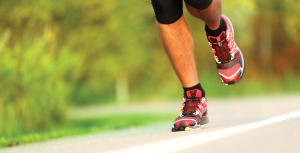Common Injuries in Runners: Plantar Fasciitis
Considering that your feet absorb a force of about three times your body weight with each stride, it is not  surprising that 15 percent of all running injuries affect the feet. The most common foot injury in runners is plantar fasciitis, a condition that causes pain in the heel and along the arch. With the help of RPM2 technology, you and your trainer can identify and correct bilateral deficiencies that often lead to this painful condition.
surprising that 15 percent of all running injuries affect the feet. The most common foot injury in runners is plantar fasciitis, a condition that causes pain in the heel and along the arch. With the help of RPM2 technology, you and your trainer can identify and correct bilateral deficiencies that often lead to this painful condition.
Plantar Fasciitis Explained
The plantar fascia is a thick, flat ligament that connects the heel bone to the toes. When this band of tissue experiences strain due to small tears or inflammation, the heel or bottom of the foot will hurt, particularly when you wake up and take your first steps in the morning. The pain typically decreases as the day goes on and your foot limbers up, but the pain may return after long periods of rest.
Risk Factors for Plantar Fasciitis
Plantar fasciitis typically strikes runners who have very high arches or flat feet, as well as those with extreme pronation or supination. Other risk factors include having tightness or weakness in the calf muscles, Achilles tendon, foot muscles, core muscles, or hip flexors.
Treating Plantar Fasciitis
Surgical intervention is rarely necessary with plantar fasciitis. Most runners find relief with conservative treatments, which may include taking a short break from running and seeing a physical therapist to learn about exercises and stretches for the feet, calves, and core muscles. Active release technique can promote healing by releasing scar tissue in and around the plantar fascia. To alleviate pain, you can ice your heel and take over-the-counter analgesics. Night splints to stretch the calf and arch and custom-fitted orthotics to properly distribute foot pressure may also be helpful.
In monitoring your step time, cadence, pace, and pressure, our footbed devices can help you identify problems in your biomechanical movements. You can then use this valuable information to adjust your training and achieve bilateral equivalence. Check out our website today to learn how RPM2 products work to help maximize your running performance.
Comments (0)
Write a comment
Rating: Bad Good
Enter the code in the box below: